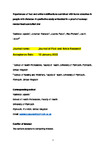Experiences of foot and ankle mobilisations combined with home stretches in people with diabetes: A qualitative study embedded in a proof-of-concept randomised controlled trial

Date
2022-01-29Author
Subject
Metadata
Show full item recordAbstract
<jats:title>Abstract</jats:title><jats:sec> <jats:title>Background</jats:title> <jats:p>The benefits of exercise and staying active are widely reported in the literature, however adherence and engagement with exercise amongst people with long-term illness and diabetes is poor. Physiotherapy aims to promote independence and physical activity using a range of strategies, including manual therapy and education/advice on exercises. However, low adherence impacts negatively on treatment outcomes. In this study, the practicality of physiotherapy interventions in patients who participate in a proof-of-concept (PoC) randomised controlled trial (RCT) will be considered.</jats:p> </jats:sec><jats:sec> <jats:title>Aim</jats:title> <jats:p>To explore the experiences of people with diabetes who received an intervention package of foot and ankle mobilisations combined with home stretches for a 6-week period.</jats:p> </jats:sec><jats:sec> <jats:title>Design</jats:title> <jats:p>An embedded qualitative study in a proof-of-concept RCT using semi-structured interviews and thematic analysis.</jats:p> </jats:sec><jats:sec> <jats:title>Participants</jats:title> <jats:p>Purposive sample of 16 participants (mean age 73 years) with a diagnosis of diabetes (mean duration 13.4 years) were recruited.</jats:p> </jats:sec><jats:sec> <jats:title>Results</jats:title> <jats:p>Analysis revealed seven themes informing the adherence and non-adherence to the exercise intervention. Themes describing the positive experiences were: 1) support from others to do the exercises; 2) psychological factors to motivate exercise adherence; 2) physical factors contributing to exercise adherence; 4) acceptability of home exercises during and beyond the study. Other themes described barriers: 5) social factors that contributed to exercise disengagement; 6) emotional limitations that influence exercise avoidance; 7) physical circumstances that made exercise participation burdensome. Themes highlighted positive influences by physiotherapists, the motivation of doing exercises while participating in a study, improving the perceived range of motion in their foot and ankle and reducing discomfort in these joints whilst being more active with daily activities.</jats:p> </jats:sec><jats:sec> <jats:title>Conclusion</jats:title> <jats:p>Our findings highlighted that the intervention of foot and ankle mobilisations combined with home stretches is feasible for study participants. Psycho-social support, self-efficacy, and physiotherapy support are motivational to adhere to the study intervention and might contribute to the success of a full-scale RCT.</jats:p> </jats:sec>
Collections
Publisher
Place of Publication
Journal
Volume
Issue
Pagination
Number
Recommended, similar items
The following license files are associated with this item:

